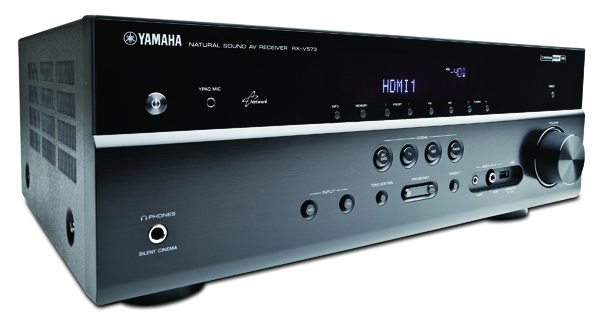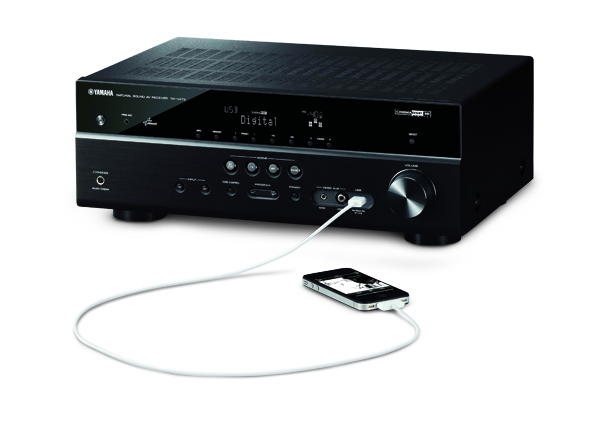Don't forget if you are powering a set of tower speakers the 573 can bi-amp. This would make a big difference for stereo listening.
Yamaha RX-V473 and RX-V573 A/V Receivers Page 2
Once those problems were fixed manually, though, the sound of the two receivers is strikingly similar. I wouldn’t go on record as calling them identical, though. Granted, audio memory is notoriously unreliable, but even in 5.1 mode, I kept gravitating toward the RX-V573 as slightly meatier sounding. I know that’s a vague description, but this is a subjective audio assessment, after all; be glad I’m not using language like “chocolaty midrange with a whiff of subtle tannins and a slice of orange-peel aftertaste.”
The point is, both the RX-V473 and RX-V573 sound fantastic for receivers in this budget range. Other than the standard distance and level settings, YPAO also automatically applies parametric EQ adjustments, which can be turned off handily in the GUI. Additionally, there’s a graphic EQ that you can adjust yourself without messing up any of the other automatic setup parameters, but I left that alone, because the automatic YPAO did exactly what I wanted it to do: tamed some bass spiking problems I have in my secondary listening room without screwing too much with the upper mids and high frequencies.

Skipping back and forth between the automated YPAO and No EQ modes, I noticed only the slightest hint of a difference in the upper end of the frequency range with my go-to demo scene for atmospheric ambience: the Pass of Caradhras sequence from the second disc of The Fellowship of the Ring Extended Edition Blu-ray (and here, I should probably apologize for not regaling you with descriptions of the very latest Blu-rays in my collection, but a new soundtrack on a new receiver just doesn’t tell me much. I prefer to stick with discs whose sound I have practically memorized, so Lord of the Rings it is).
With and without YPAO’s parametric EQ engaged, the airiness of the DTS-HD Master Audio soundtrack shines through beautifully on both the RX-V473 and RX-V573. The notoriously difficult dialogue in the following Mines of Moria sequence is also delivered with wonderful clarity.
The true test of YPAO came several discs later, though, with Battle of the Pelennor Fields from the second disc of Return of the King Extended Edition. The mix is incredibly dense, with dialogue and thundering action being equally important to the experience. I’m generally of a mind, when it comes to inexpensive room correction, that “that government is best which governs least.” But in this room, I do need some help smoothing out some bass flabbiness. YPAO handles that with aplomb, delivering all the raucousness and bottom-end boom of the battle without any slop, and without deadening the overall sound experience in the slightest. Granted, that means that if you’re in a room with too many bright, sonically reflective surfaces, the room correction onboard the RX-V473 and RX-V573 might not be the best at taming those. But it’s been my experience that any room correction system capable of doing so often adds more to the cost of a receiver or preamp than the entire sticker price of either of these models.

I also tried out the RX-V473 and RX-V573’s Eco Mode, which reduces power usage in a number of ways, but it really robbed the soundtracks of essential energy, so I wouldn’t recommend engaging it.
Ironically, my choice of tunes when testing these receivers did depart from the norm. The rather new-ish self-titled album from Thao & Mirah is such an eclectic mix of organic and electronic—of folk guitars and drum-machine beats, of Thao Nguyen’s slightly crazy energy and Mirah’s shy reservation—that it makes for incredibly interesting demo material. About two minutes into the track “Likeable Man,” the duo go into a sort of loose, drunken round, followed by a chaotic, almost jazz-like instrumental breakdown, all of which has a tendency to sound like absolute muddled garbage through lesser sound systems, but really mesmerizingly layered through gear capable of resolving and delivering the nuances. Through both the RX-V473 and RX-V573—via AirPlay, DLNA, or directly from the CD via my OPPO BD-93 Blu-ray player—it sounded positively delicious. Even in stereo mode! One of the cool things about Yamaha, though, is that it has its own DSP programs, distinct from the Hall and Club settings you’ll find on virtually every other mass-market receiver. And as much as it shames me to admit it, a few of them don’t suck. Especially Cellar Club and The Bottom Line.
I know. I’m as shocked as you are.
But both of these DSP programs added radically different ambience to the music, without making it sound processed or gimmicky. The stalwarts like PLII: Music and Neo:6 Music are also here, although switching between Yamaha’s DSP modes and the others is handled via different buttons on the ridiculously cluttered remote, for some reason. There’s also a Direct button that disables unnecessary circuitry for a more pure music playback experience, but to be quite frank, I must have turned it on and off a hundred times trying to hear a difference and simply couldn’t make the slightest distinction from a reasonable listening distance.

Conclusion
Before passing a yea or nay vote on either the Yamaha RX-V473 or RX-V573, let’s address a few big issues that might put either of these receivers out of the running for you. If you’re looking for all the latest streaming audio features like Pandora and Spotify, you won’t find them here, unless, of course, you count the fact that they’re readily available via your iDevice when using AirPlay. Also, if you need more than four HDMI inputs, you’re also out of luck.
That said, if you’re not hung up on all the latest over-the-top features, and don’t have tons of devices to hook up to an A/V receiver, both the RX-V473 and RX-V573 deliver something that so few receivers in this price range do: really, really solid sound quality for the coin.
If you’ve settled on Yamaha as your brand of choice, and $500 (ish) is your budget, picking between them is mostly easy. If you only need 5.1 channels of amplification, the RX-V473 is your guy. If you want to step up to 7.1, you’ll want to opt for the RX-V573.
What about the (remember, very subjective) improvements in sound quality I ascribed to the RX-V573? Really, that could come down to all sorts of things.
Either way, it’s not $100 worth of difference. So I would make my purchasing choice solely on whether I needed 5.1 or 7.1. Whichever you choose, if sound quality is more important to you than a laundry list of features—and you don’t mind budgeting for a good universal remote control—I’d say you’ll be happy with your purchase.
- Log in or register to post comments


How and i mean how is this a good deal? This is 350$ and their is pioneer receivers and even other Yamaha receivers with more power it can't even be loaded at 7 channels continuously.
This is just sad and its even more sad you guys gave it a 4.5 on the charts(audio) i used to come her every single day reading not replying but this by all means is sad its weaker then Pioneer 521-K for just 200$.
Not even good enough for most satellite systems.
This should be a quad only company at least their mediocre at that.
And you guys should be ashamed.


Nice Review. AVR good for high sensitivity speakers.

Very accurate review of the AVRs.
Note also that the RX-V473 is also the HTR-4065, which was sold at Costco and later, other stores.
“The only downside to Yamaha’s AirPlay implementation on these models is that you can’t use AirPlay itself to power on the receivers.”
There is Network Standby on these AVRs. See page 78 of manual. It “Selects whether the unit can be turned on from other network devices.” It consumes 2 W of power.
I’ve not been able to get it to work (turn on AVR when selected to play from iTunes) but, the Yamaha YWA-10BL Wireless Network Adapter is on and showing the AVR on the Airplay menu in iTunes. I suspect, because it is a disordered manual and inflexible interface, I just have something set wrong. (The setup, manual, UI, and complexity - the whole ball of wax with this unit - is what *bad* user experience design is.)
It is a hard unit to set up. On that alone, I would recommend a more expensive Yamaha or an AVR known for ease of set up and ease of use and well designed interface with decent typography.
For the technically adept, very patient, bargain hunter, it is as described in the review. Now that it is no longer made, it is also way cheaper. I see the 473 for $300 now, new. The YWA-10BL is also $50 now.

Yamaha receivers have always been good, no question asked. I have the YWA-10bl and i`m happy with it.






























































